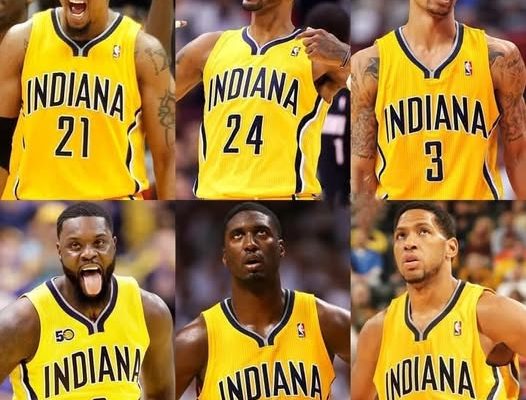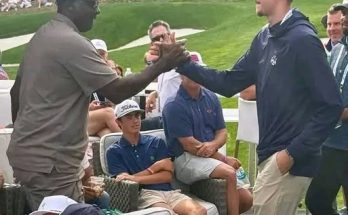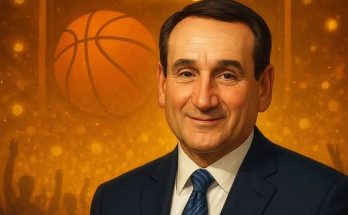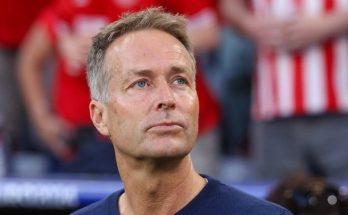This Pacers squad was the only legitimate LeBron James threat in the East during the earlier part of the 2010s, and they made sure the entire basketball world knew it. What made the Indiana Pacers between 2012 and 2014 so unique wasn’t that they had a transcendent superstar or a perennial MVP candidate—it was the sheer will, unity, and relentless physicality they brought to every possession. This wasn’t a team built on highlight reels or flashy offense. This was a group of men who committed to gritting out games, dragging elite offenses into the mud, and pushing the greatest player of his generation—LeBron James—to the brink of elimination more than once. What they lacked in star power, they made up for with a defensive identity that turned Bankers Life Fieldhouse into one of the most hostile environments in the league.
The heart and soul of those Pacers teams was a young, rapidly rising Paul George. Before devastating injuries and trades would alter the arc of his career, George blossomed on the playoff stage, and it was against LeBron James that he showed the world he was more than just a promising wing. In the 2013 and 2014 Eastern Conference Finals, George went toe-to-toe with LeBron, often guarding him one-on-one while also being Indiana’s top scorer. At just 23 years old in the 2013 playoffs, he wasn’t afraid of the moment. He dunked on LeBron. He hit clutch threes. He answered the challenge time and again, evolving from an under-the-radar pick to a legitimate franchise cornerstone in real time. There’s no question that George’s playoff battles with Miami helped mold him into the All-NBA-caliber player he would become.
Yet George alone didn’t make Indiana a threat. It was the perfectly constructed roster around him that gave Miami—and particularly LeBron—so many problems. Roy Hibbert was the Pacers’ anchor in the paint, and although his fall from relevance in the years following was dramatic, during that stretch he was arguably the league’s most effective rim protector. In 2013, Hibbert averaged over 2 blocks per game in the playoffs and altered countless others. His verticality was a cornerstone of Indiana’s defensive scheme, and his ability to challenge LeBron at the rim without fouling became a source of frustration for Miami’s attack. Back when verticality wasn’t yet a catchphrase, Hibbert embodied it and, in doing so, helped redefine the role of the rim-protecting big man in the modern NBA.
On the wings, the Pacers deployed a pair of relentless defenders in Lance Stephenson and George Hill. Stephenson, in particular, became a lightning rod in the LeBron rivalry. His antics—blowing in LeBron’s ear, jawing constantly, flopping and flailing—were polarizing, but they were also effective. He got under LeBron’s skin in a way few others could. For all of the drama Stephenson brought to the court, he was also a versatile defender, a capable ball-handler, and one of the most physically imposing guards in the league. George Hill was more subdued, but equally important. His size and defensive discipline helped take pressure off George and allowed Indiana to switch with confidence. Together, Stephenson and Hill formed the backcourt wall that kept perimeter scorers in check and forced Miami into a grind-it-out style they didn’t always prefer.
David West, the veteran bruiser, brought experience, leadership, and an edge to this group. He was the emotional backbone of the Pacers. West didn’t shy away from contact—he invited it. He was Indiana’s enforcer, the guy who would set a crushing screen, throw an elbow, and stare down a referee all in the same sequence. His midrange jumper was automatic, and his ability to space the floor made Hibbert’s paint-clogging presence more viable. But more than anything, West gave Indiana its swagger. He didn’t fear Miami’s star-studded lineup. In fact, he seemed to relish the opportunity to test his mettle against them. When the games got tense and tempers flared, it was West who made sure Indiana didn’t blink.
Together, this core built a culture that thrived on toughness, cohesion, and a singular belief: they could beat anyone. That belief was tested each time they faced the Miami Heat, particularly in the playoffs. In 2012, the Pacers pushed Miami to six games in the Eastern Conference Semifinals. They even led the series 2–1 before Miami, behind LeBron and Wade, reeled off three straight wins. But it was the warning shot that announced Indiana’s arrival as a legitimate contender. A year later, they met in the Eastern Conference Finals. That 2013 series was a war. Every game was a fistfight. The series went seven, and Indiana—despite lacking the experience of Miami’s trio of superstars—matched their intensity blow for blow. LeBron ultimately prevailed, but even he acknowledged how physically and mentally taxing that series had been.
In 2014, the two teams met again in the Eastern Conference Finals. By then, Indiana had spent the entire regular season preparing for that one opponent. They chased the top seed with the express goal of securing home court against Miami, believing it would be the difference. The Pacers even started the season 33–7 and led the Eastern Conference for months. But internal chemistry issues, the enigmatic behavior of Stephenson, and the emergence of locker room drama would derail their cohesion. By the time they met Miami again in the playoffs, Indiana wasn’t quite the same team. Still, they fought. Game 5 was a statement—Paul George scored 37 points in a virtuoso performance to stave off elimination. But it wasn’t enough. Miami closed the series in six, sending Indiana home once more.
Even though they never broke through and reached the Finals, this Pacers team earned respect around the league. They weren’t just another stepping stone on LeBron’s path to greatness. They were a roadblock that demanded everything he had to overcome. And in some ways, they exposed the blueprint to slowing down peak LeBron: limit transition opportunities, wall off the paint with a mobile big, and force him into tough jumpers late in the clock. Miami’s offense—so deadly against most opponents—was often clunky against Indiana. Chris Bosh struggled to find rhythm. Dwyane Wade’s knees limited his burst. Even LeBron had games where he seemed mortal.
The rivalry between Indiana and Miami during those years brought a level of competitiveness to the Eastern Conference that had been missing since the Celtics’ Big 3 faded. And it gave fans memorable moments that still echo in NBA lore. Paul George’s thunderous dunk over Birdman. LeBron fouling out in Game 4 of the 2013 ECF. Stephenson’s antics reaching meme-level fame. Hibbert’s controversial “no homo” remark during a postgame interview. West barking at Shane Battier. All of it made for a rivalry that, while short-lived, burned hot.
But what ultimately doomed the Pacers wasn’t just Miami’s excellence—it was the fragile nature of their team chemistry and the narrow margin for error their style of play allowed. They didn’t have the offensive firepower to survive off nights. They couldn’t play from behind comfortably. If the defense slipped even slightly, they were vulnerable. And once Hibbert’s game declined and Stephenson left for Charlotte, the core began to unravel. Paul George’s horrific leg injury during a Team USA scrimmage in 2014 sent the franchise into a new era. They rebuilt around him when he returned, but the magic of that 2012–2014 window had passed.
Yet in hindsight, the legacy of that Pacers team is undeniable. They were one of the few teams that truly challenged LeBron James when he was at the peak of his powers. They weren’t intimidated by the aura of the Heatles. They weren’t looking to be liked. They wanted to win, and they believed they could. In an Eastern Conference that largely failed to stand up to LeBron during his near-decade of dominance, Indiana fought back. They made him earn every inch. And while history will always remember LeBron’s Finals appearances, those Indiana battles were the fire he had to pass through to get there. The Pacers may not have won the war, but they certainly won the respect of everyone who watched them fight.



